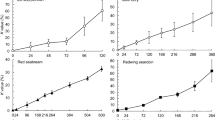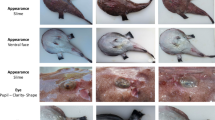Abstract
The traditional indictors of fish freshness including total aerobic count (TAC), K value, total volatile basic nitrogen (TVB-N), and sensory assessment (SA) were measured regularly to analyze the freshness changes during chill storage. Electric conduction property of whole fish was also studied by measuring their impedances under different frequencies as a fast nondestructive method. The relationship between traditional freshness indictors and electric conductivity was analyzed to determine the feasibility of evaluating fish freshness based on impedance change ratio (Q value) during storage. The results showed that traditional freshness indictors (TAC, K value, and TVB-N) values increased as storage time prolonged, while Q value and SA decreased. There were good relationships between Q value and TAC, K value, TVB-N, and SA (P < 0.01), with the correlation coefficients were 0.943, 0.996, 0.951, and 0.968, respectively. Thus, Q value can be used as a valid index for freshness evaluation and this method via measuring the electric conductivity property of whole fish is a fast nondestructive method for determining the freshness of fish during storage.



Similar content being viewed by others
References
Olafsdottir G, Martinsdottir E, Oehlenschlager J, Dalgaarg P, Undeland I, Mackie IM et al (1997) Method to evaluate fish freshness in research and industry. Trends Food Sci Technol 8:258–265
Grigorakis K (2007) Compositional and organoleptic quality of farmed and wild gilthead sea bream (Sparus aurata) and sea bass (Dicentrarchus labrax) and factors affecting it: a review. Aquaculture 272:55–75
Bremner HA, Sakaguchi M (2000) A critical look at whether ‘freshness’ can be determined. J Aquat Food Pro Technol 9:5–25
Baixas-Nogueras S, Bover-Cid S, Veciana-Nogueäs T, Vidal-Carou MC (2002) Chemical and sensory changes in mediterranean hake (Merluccius merluccius) under refrigeration (6–8 °C) and stored in Ice. J Agric Food Chem 50:6504–6510
Campus M, Addis MF, Cappuccinelli R, Porcu MC, Pretti L, Tedde V, Secchi N, Stara G, Roggio T (2010) Stress relaxation behaviour and structural changes of muscle tissues from Gilthead Sea Bream (Sparus aurata L.) following high pressure treatment. J Food Eng 96:192–198
Cao R, Xue CH, Liu Q, Yin BZ (2009) Microbiological, chemical and sensory assessment of (I) whole ungutted, (II) whole gutted and (III) filleted tilapia (Oreochromis niloticus) during refrigerated storage. Int J Food Sci Technol 44:2243–2248
Barat JM, Gill L, García-Breijo E, Aristoy MC, Toldrá F, Martíneai -Mañez R, Soto J (2008) Freshness monitoring of sea bream with a potentiometric sensor. Food Chem 108:681–688
Barsoukov E, Macdonald J, Ross (eds) (2005) Impedance spectroscropy theory, experiment, and applications, 2nd edn. Wiley, Hoboken
Damez JL, Clerjon S (2008) Meat quality assessment using biophysical methods related to meat structure. Meat Sci 80:132–149
Jukna V, Jukna Č, Pečiulaitiene N, Kerinas E (2009) Influence of cattle sex and age on carcass yield and muscularity class Galviju{ogonek} lyties ir amžiaus itaka skerdenu{ogonek} išeigai ir raumeningumo klasei. Veterinarija ir Zootechnika 46:20–23
Kleinová I, Ingr I (1999) Dynamics of pH and electric conductivity values in longissimus and semimembranosus muscles of pigs [Vývoj hodnot pH a elektrické vodivosti ve vepřovém mase v průběhu zrání]. Czech J Anim Sci 44:551–554
Tejada M, Heras CDL, Kent M (2007) Changes in the quality indices during ice storage of farmed Senegalese sole (Solea senegalensis). Eur Food Res Technol 225:225–232
Niu J, Lee JY (2000) A new approach for the determination of fish freshness by electrochemical impedance spectroscopy. J Food Sci 65:780–785
Rümenappa C, Remm M, Wolf B, Gleich B (2009) Improved method for impedance measurements of mammalian cells. Biosens Bioelectron 24:2915–2919
Zhang LN, Shen HX, Luo YK (2010) Study on the electric conduction properties of fresh and frozen-thawed grass carp (Ctenopharyngodon idellus) and tilapia (Oreochromis niloticus). Int J Food Sci Technol 45:2560–2564
AOAC (2002) Official methods of analysis, 17th edn. Association of Official Analytical Chemists, Washington, DC
Song YL, Liu L, Shen HX, You J, Luo YK (2011) Effect of sodium alginate-based edible coating containing different anti-oxidants on quality and shelf life of refrigerated bream (Megalobrama amblycephala). Food Control 22:608–615
Karube I, Matsuoka H, Suzuki S, Watanabe E, Toyama K (1984) Determination of fish freshness with an enzyme sensor system. J Agric Food Chem 32:314–319
Özogul F, Özogul Y (2000) Comparison of methods used for determination of total volatile basic nitrogen (TVB-N) in rainbow trout (Oncorhynchus mykiss). Turk J Zool 24:113–120
Ojagh SM, Rezaei M, Razavi SH, Hosseini SMH (2010) Effect of chitosan coatings enriched with cinnamon oil on the quality of refrigerated rainbow trout. Food Chem 120:193–198
Chytiri S, Chouliara I, Savvaidis IN (2004) Microbiological, chemical and sensory assessment of iced whole and filleted aquacultured rainbow trout. Food Microbial 21:157–165
Özyurt G, Kuley E, Özkutuk S, Özogul F (2009) Sensory, microbiological and chemical assessment of the freshness of red mullet (Mullus barbatus) and goldband goatfish (Upeneus moluccensis) during storage in ice. Food Chem 114:505–510
Beatty S (1938) Studies of fish spoilage. II. The origin of trimethylamine produced during the spoilage of cod muscle press juice. J Fish Res Board Canada 4:63
Ruiz-Capillas C, Moral A (2005) Sensory and biochemical aspects of quality of whole bigeye tuna (Thunnus obesus) during bulk storage in controlled atmospheres. Food Chem 89:347–354
Scherer R, Augusti PR, Bochi VC, Steffens C, Fries LLM, Daniel AP, Kubota EH, Neto JR, Emanuelli T (2006) Chemical and microbiological quality of grass carp (Ctenopharyngodon idella) slaughtered by different methods. Food Chem 99:136–142
Goncü Alves AC, Antas SE, Nunes ML (2007) Freshness and quality criteria of iced farmed senegalese sole (Solea senegalensis). J Agric Food Chem 55:3452–3461
Ehira S, Uchiyama H (1974) Freshness lowering rates of cod and seabream viewed from changes in bacterial count, total volatile base and trimethylamine–nitrogen and ATP related compounds. Bull Jpn Soc Sci Fish 40:479–487
Chang KLB, Chang J, Shiau CY, Pan BS (1998) Biochemical, microbiological, and densory changes of sea bass (Lateolabrax japonicus) under partial freezing and refrigerated storage. J Agric Food Chem 46:682–686
Bozkurt H, Icier F (2010) Electrical conductivity changes of minced beef–fat blends during ohmic cooking. J Food Eng 96:86–92
Marshall DL, Wiese-Lehigh PL (1997) Comparison of impedance, microbial, sensory, and pH methods to determine shrimp quality. J Aquatic Food Product Technol 6:17–31
Acknowledgments
This study was supported by the earmarked fund for China Agriculture Research System (CARS-46).
Author information
Authors and Affiliations
Corresponding author
Rights and permissions
About this article
Cite this article
Zhang, L., Shen, H. & Luo, Y. A nondestructive method for estimating freshness of freshwater fish. Eur Food Res Technol 232, 979–984 (2011). https://doi.org/10.1007/s00217-011-1467-z
Received:
Revised:
Accepted:
Published:
Issue Date:
DOI: https://doi.org/10.1007/s00217-011-1467-z




